To master your mandoline slicer and achieve perfect, even cuts without risking injuries, always prioritize safety features like guards and hand protectors. Choose a model with the right blade types for your needs, and guarantee blades are sharp and well-maintained. Use proper technique—steady, controlled strokes with fingers curled and safety gear in place. With careful setup, proper use, and regular maintenance, you’ll cut confidently. Keep exploring tips to stay safe and perfect your slicing skills.
Key Takeaways
- Always use safety guards or hand protectors to shield fingers during slicing.
- Choose a mandoline with appropriate blades and safety features suited to your skill level.
- Keep blades sharp and well-maintained to ensure smooth cuts and reduce injury risk.
- Work slowly, control the produce, and adjust thickness gradually for even slices.
- Disassemble and clean your mandoline carefully, storing blades securely to prevent accidents.
Understanding the Different Types of Mandoline Blades and How They Work
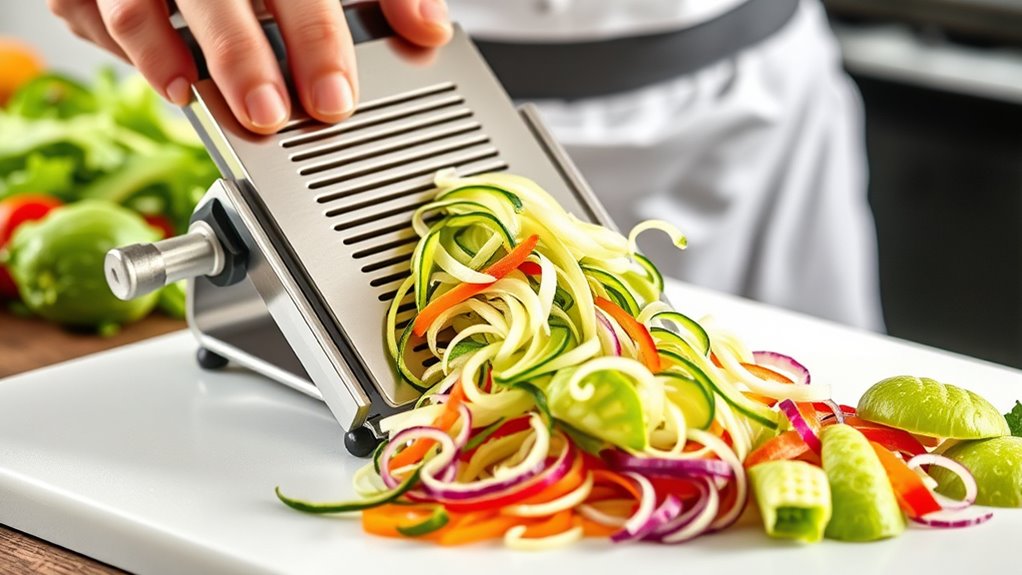
To get the most out of your mandoline, it is essential to understand the different types of blades and how they work. Straight blades offer uniform slices and are adjustable for consistent thickness, making them ideal for even cuts. V-shaped blades reduce resistance and make slicing easier, allowing for thinner, more precise cuts with less effort. Corrugated blades produce wavy or ruffled designs, perfect for decorative garnishes. Interchangeable blades and julienne attachments greatly expand your options, letting you create everything from thin slices to matchstick juliennes. Each blade type serves a specific slicing technique, so understanding their functions helps you select the right one for your culinary needs. Mastering these blades ensures safer, more efficient, and beautifully even cuts every time. Proper blade maintenance also plays a crucial role in ensuring longevity and optimal performance of your mandoline.
Choosing the Right Mandoline for Your Kitchen Needs
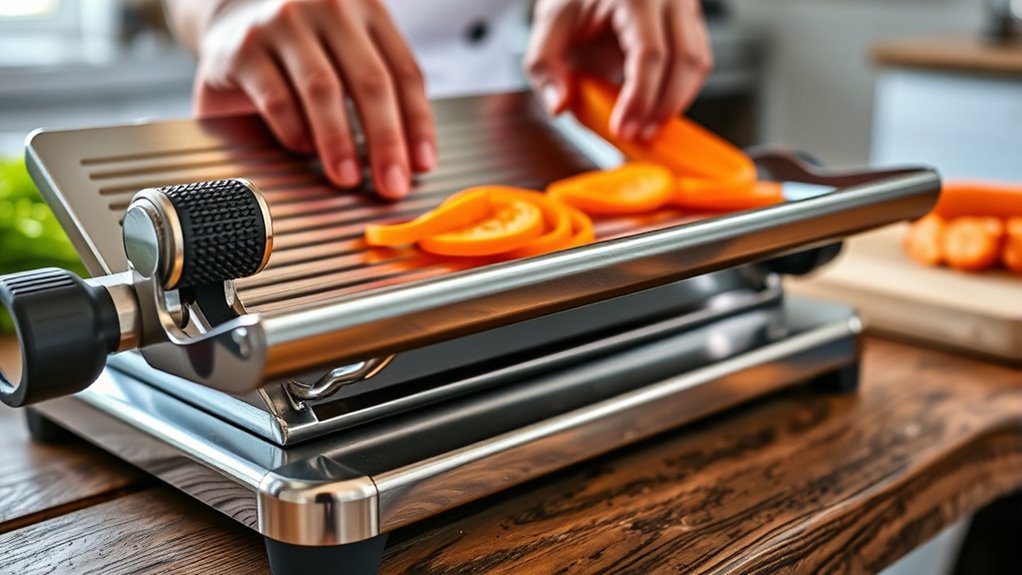
Selecting the right mandoline depends on your kitchen space, cooking style, and safety preferences. Consider the size and storage options—slim Japanese models fit small spaces, while larger French styles offer stability and versatility. Evaluate blade types like V-shaped, straight, or waffle, to match your slicing needs. Look for adjustable thickness controls, whether via dials or presets, to get precise cuts for different recipes. Prioritize safety features such as a safety guard, blade safety, and a non-slip base to prevent accidents during use. Also, think about your skill level: beginner models tend to be simple, while professional-grade mandolines offer more customization and storage options. Incorporating projector technology can enhance your viewing experience when choosing a setup for your kitchen or entertainment space. Additionally, selecting a model with ergonomic handles can improve comfort during extended use. Remember that attention in your technique can significantly improve your slicing accuracy, making your cooking both safer and more efficient. Choosing the right mandoline makes slicing safer, easier, and more efficient.
Essential Safety Features and How to Use Them Properly
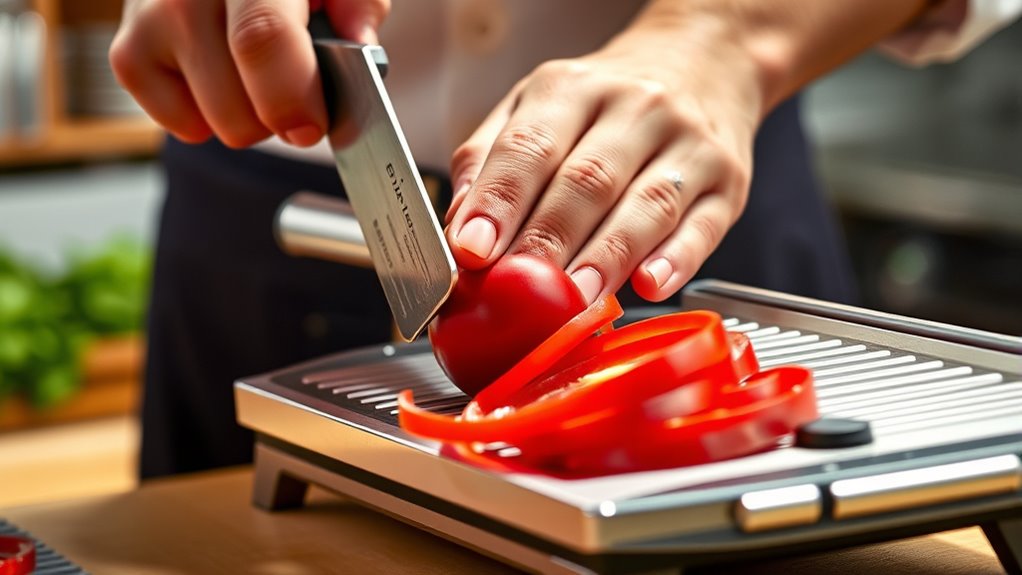
Ensuring safety while using a mandoline starts with understanding its essential safety features and how to operate them properly. Always use the included safety guard or hand protector to shield your fingers from the sharp blades during cutting. Make sure the blades are dry and handle them carefully when cleaning or changing to avoid cuts, avoiding direct contact in the sink. Before use, adjust and lock the security features, like blade guards and thickness settings, securely to prevent shifting during slicing. Place your mandoline on a stable, flat surface with non-slip feet to prevent slipping. When slicing small or delicate pieces, avoid using the blades directly; instead, use a knife for the end pieces. Properly utilizing these features minimizes risk and ensures safe, efficient cutting. Additionally, understanding the safety features of your mandoline can significantly reduce potential injuries during use. Familiarizing yourself with mandoline safety guidelines can further enhance your safety practices and confidence in handling the device. Regularly inspecting the blade mechanism for wear or damage can help prevent accidents and ensure optimal performance. Always remember that proper maintenance of your mandoline contributes to both safety and longevity of the tool.
Step-by-Step Guide to Preparing Your Mandoline for Slicing
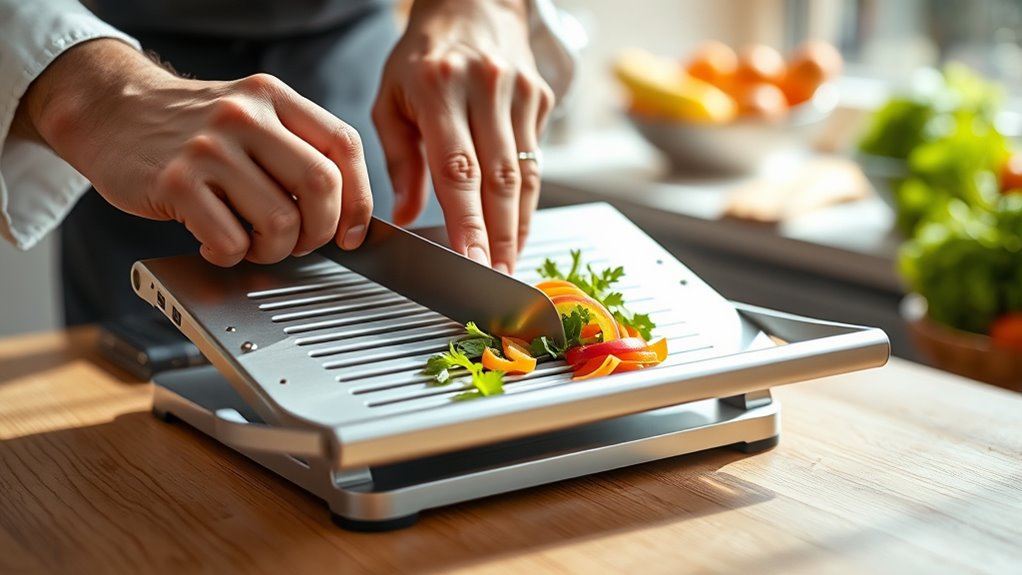
Before you start slicing, it’s important to properly prepare your mandoline to guarantee safe and efficient operation. First, carefully assemble the mandoline, ensuring all blades are securely locked into place. Familiarize yourself with the safety guard or hand protector to prevent injuries. Next, adjust the thickness setting using the dial or control knob, referencing the marked indicators for precision. Check that the surface is stable on a flat, non-slip workspace to keep it secure during use. Always test the mandoline on a small piece of produce to confirm proper assembly and settings before slicing larger quantities. Additionally, be aware of safety guidelines outlined in the Louisiana Civil Code to ensure safe handling and usage of your equipment. Remember that safety precautions are essential for preventing accidents and injuries while using the mandoline. Understanding the proper technique for using the mandoline can further help prevent mishaps and improve your slicing consistency. Practicing proper blade handling techniques is crucial for both safety and achieving uniform slices. Incorporating the use of non-slip mats can also enhance stability during use, reducing the risk of slips or accidents.
Demonstrating Proper Technique for Thin, Even Slices
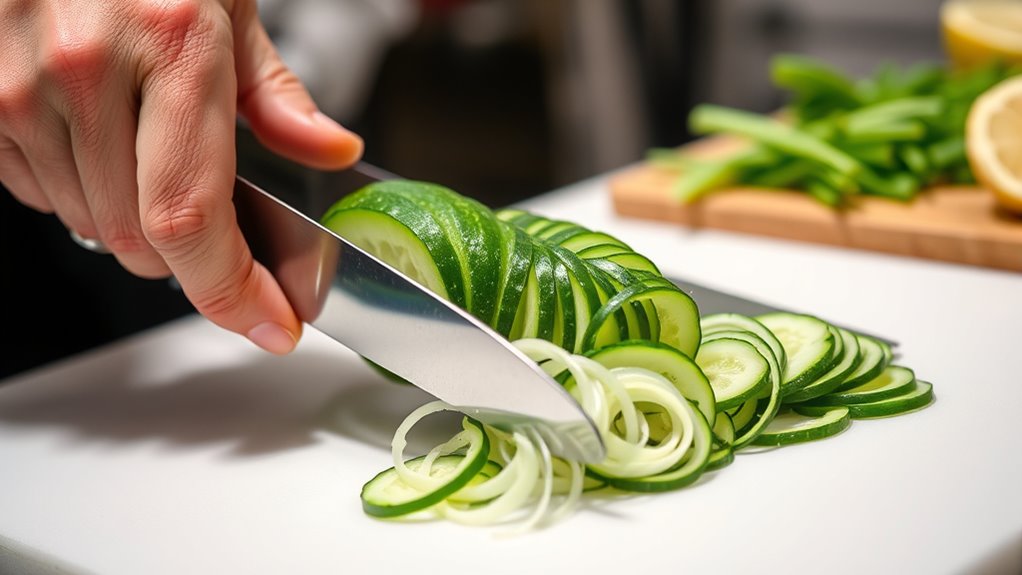
To achieve thin, even slices with your mandoline, focus on maintaining a steady hand and proper technique throughout each pass. Keep the safety guard or hand protector in place to guarantee control and safety, and grip the handle firmly. Adjust the thickness setting precisely, starting with a thicker slice to build confidence, then gradually lowering it for finer cuts. Use smooth, even strokes, letting the sharp blade do the work with minimal force—this helps produce uniform slices. Maintain steady pressure and a consistent angle, moving confidently across the produce. Periodically check your slices for evenness, fine-tuning the control or adjusting the thickness adjustment as needed. Practicing proper safety precautions and technique will help prevent accidents and improve your slicing precision. With focus and proper technique, you’ll master thin, even slices effortlessly and safely.
Tips for Maintaining and Sharpening Your Mandoline Blades

Regularly inspecting your mandoline blades is essential because dull or nicked blades compromise safety and slicing quality. Sharp blades cut effortlessly, reducing the risk of slips and accidents. To maintain blades, keep them clean and dry after each use, removing any food residue with a soft brush or cloth. This prevents buildup that dulls the edge. When blades become dull, use sharpening tools or professional sharpening services to restore their edge quality, ensuring consistent, precise slices. Be sure to maintain the original bevel angle during sharpening to avoid uneven edges. If sharpening no longer restores sharpness, it’s time for blade replacement. Proper maintenance and sharpening not only extend your mandoline’s lifespan but also keep your slicing safe and efficient. Regularly checking your equipment ensures that you stay prepared and resilient in your kitchen routines.
Common Mistakes to Avoid When Using a Mandoline
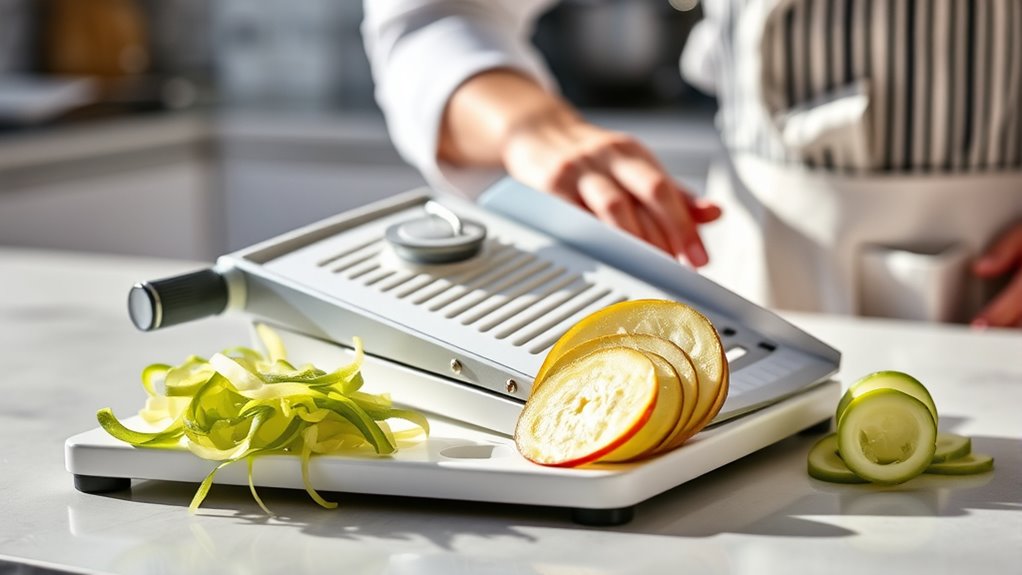
One common mistake is neglecting safety measures, which can lead to serious injuries. Using dull blades also increases the risk of slipping and cutting yourself, so keeping them sharp is essential. Additionally, rushing or forcing slices can cause slips—work slowly and use the safety guard at all times. Be aware of potential scam risks associated with kitchen tools, and only purchase from reputable sources to ensure product safety and quality. Remember that sharp blades are crucial for both safety and precision when operating a mandoline. Ensuring the correct technique is also vital to avoid accidents and achieve even cuts. Regular maintenance and understanding air purifier maintenance dos and don’ts can help ensure your equipment functions safely and efficiently.
Neglecting Safety Measures
Neglecting safety measures when using a mandoline can lead to serious injuries. Without proper precautions, sharp blades pose a significant risk of cuts and accidental slips. Always use the safety guard or hand protection to prevent injury, as the blades are extremely sharp—comparable to a dagger. Rushing through slices increases the chance of losing control and slipping, so take your time and work deliberately. Failing to check the security features or clean and reassemble the mandoline properly can cause instability, elevating accident risks. Remember, injury prevention depends on using the right safety tools and respecting the blade sharpness.
- Skip safety guards or hand protectors, risking cuts
- Work too quickly, causing accidental slips
- Ignore security features or improper cleaning
- Fail to handle blades with care, risking injury
Using Dull Blades
Have you noticed that dull blades make slicing more difficult and dangerous? Dull blades require extra pressure, increasing the risk of slips and accidental cuts, compromising safety. They produce ragged, uneven slices, which can trap food and make handling small or slippery ingredients hazardous. Using dull blades also reduces cutting control, forcing you to apply more force and risking loss of stability. Regular blade maintenance, including sharpening or replacing dull blades, enhances safety and precision. Sharp blades cut smoothly, minimizing uneven slices and making food prep safer. Remember, a dull blade not only impairs safety but also diminishes food safety, as uneven slices can lead to inconsistent cooking. Keep your blades sharp to ensure safety, efficiency, and perfect results every time.
Using Safety Gear to Protect Your Hands During Slicing
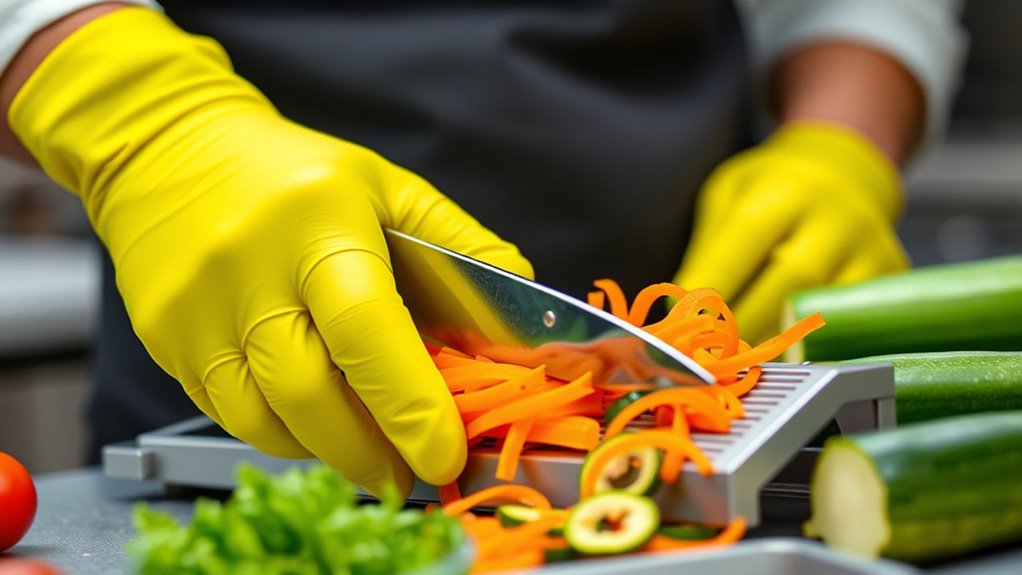
Using safety gear is essential for protecting your hands while slicing with a mandoline. It markedly reduces the risk of cuts and injuries during food prep. Always wear a cut-resistant glove or safety guard to provide hand protection, especially when working quickly or with dull blades. Use the included food holder or safety guard to keep your fingers away from the sharp blade, preventing injuries. Proper hand positioning, with fingers curled inward and knuckles guiding the food, enhances safety. Keep your hands dry and clean to guarantee a firm grip, reducing slips. Regularly inspect your safety gear for wear or damage and replace as needed for maximum protection.
Always wear safety gear and use proper hand positioning to ensure safe slicing with a mandoline.
- Wear a cut-resistant glove or safety guard for added protection
- Use the food holder to keep fingers safe during slicing
- Position your hand correctly, with curled fingers and guiding knuckles
- Check safety gear regularly to ensure ideal hand protection
Cleaning and Storing Your Mandoline for Longevity and Safety
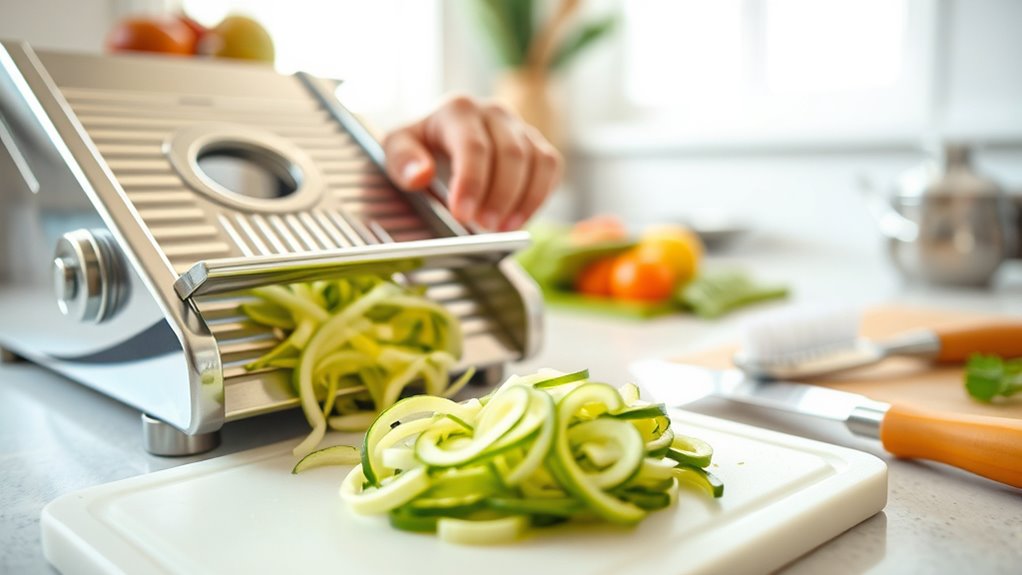
To guarantee your mandoline stays safe and functions well over time, proper cleaning and storage are essential. After each use, carefully disassemble the blade, handling it with a cut-resistant glove or cloth to avoid cuts. Use a small brush or toothbrush to scrub hard-to-reach areas and remove food debris from the blades and crevices. Hand wash all components with warm, soapy water immediately, avoiding the dishwasher unless specified safe by the manufacturer. Dry all parts thoroughly with a clean towel to prevent rust, especially on metal blades and platforms. For storage, keep blades in a dedicated case or drawer with blade covers to protect the sharp edges and prevent accidental injuries. Proper cleaning and storage ensure your mandoline remains safe, sharp, and ready for perfect cuts.
Creative Recipes and Ideas to Maximize Your Mandoline Skills

Using your mandoline opens up endless possibilities for creating vibrant vegetable chips and stunning garnishes. With precise cuts, you can turn simple ingredients into artistic plating elements that wow your guests. Elevate your dishes by experimenting with decorative layers and intricate vegetable designs that showcase your skills.
Vibrant Vegetable Chips
Have you ever considered how your mandoline can transform simple vegetables into stunning, crispy chips? With a mandoline slicer, you can create vegetable chips that crisp evenly during baking or frying. Use the adjustable mandoline’s thickness settings to make thin slices, around 0.3 mm, perfect for delicate textures. Sharp blades ensure clean, uniform slices, maximizing food safety and reducing the risk of slips. Experiment with root vegetables like sweet potatoes and beets, or try zucchini, carrots, and eggplant for vibrant varieties. Before cooking, season your slices with herbs or spices to elevate their flavor. Store any leftovers in an airtight container to maintain crispness or enjoy immediately for maximum crunch. Perfect slices are key to gourmet veggie chips—get slicing!
Artistic Garnishes and Platings
Mastering your mandoline opens up a world of creative garnishing and plating techniques that can elevate any dish. With its adjustable blades, you can produce uniform slices perfect for artistic garnishes like lemon twists or cucumber rosettes, enhancing plate presentation. Use the fine shredding option for textured garnishes such as herbs or cheese, adding visual interest and flavor contrast. Combine crinkle or wavy blades with colorful vegetables like carrots and radishes to craft layered salads and eye-catching plate accents. Julienne or waffle-cut blades allow you to create vegetable spirals and lattice toppings, perfect for dishes like tartare or savory tarts. Incorporating vibrant, evenly sliced produce elevates the visual appeal, making your dishes look more professional and irresistible.
Frequently Asked Questions
How Do You Protect Your Fingers When Using a Mandoline?
You protect your fingers by always using the included hand guard or safety holder to keep your fingers away from the blades. Wear cut-resistant gloves for extra safety, especially on small or irregular items. Keep your fingers behind the safety guard and avoid reaching over the blades. Maintain a firm grip on the food and the mandoline, and regularly check your safety equipment to guarantee it’s in good condition.
What Is the Best Mandoline Slicer on the Market?
Did you know that the Swissmar Borner V-1001 V-Slicer Plus is rated as one of the safest and most versatile mandolines? When choosing the best, consider safety features, adjustable thickness, and ease of use. The Swissmar model excels in all these areas, making it ideal for home cooks and pros alike. Its sturdy design and safety guard help you slice confidently without risking your fingers.
What Are the Disadvantages of a Mandoline Slicer?
You should know that mandoline slicers can be risky if safety features aren’t used properly. Dull blades make you apply more force, increasing slips and cuts. Small or awkward guards can mislead you about finger proximity. Some models are tricky to assemble or clean, leading to accidents. Also, over sharp blades or poor maintenance can cause unexpected slips, especially with tough or uneven produce. Always prioritize safety to avoid injuries.
What Is the V Blade for on a Mandoline?
Imagine a blade from the Victorian era, sharp and precise—now, that’s what a V blade on your mandoline is like. It’s designed to make cleaner, more uniform slices with less effort. You’ll find it especially helpful for firm veggies like potatoes and carrots, as it reduces tearing and slipping. Plus, it minimizes resistance, making slicing safer and easier, giving you professional results every time without the frustration.
Conclusion
Mastering your mandoline is like wielding a precision instrument—when used correctly, it transforms your prep work into effortless art. Always prioritize safety, choose the right blades, and practice proper technique to slice with confidence. With a little care and attention, you’ll create perfect, even cuts every time—like a chef with a steady hand. So go ahead, get slicing, and let your culinary creativity shine!









